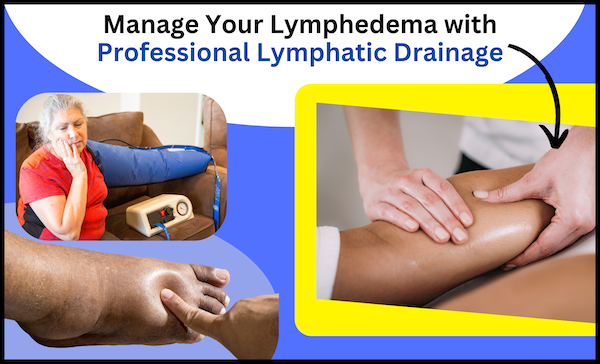Lymphatic Massage for Lymphedema Albuquerque

Lymphedema is a chronic and often debilitating condition characterized by the swelling of limbs due to an impaired lymphatic system. It can result from various factors, such as surgery, radiation therapy, infection, or congenital conditions, and it poses significant challenges to those who suffer from it. Fortunately, one of the cornerstones of lymphedema management is Manual Lymphatic Drainage (MLD), a specialized gentle skin stretching technique, can offer relief and improve the quality of life for individuals with lymphedema.
Understanding Manual Lymphatic Drainage (MLD)
Manual Lymphatic Drainage, often simply referred to as “lymphatic massage,” is a gentle, hands-on technique designed to encourage the natural flow of lymphatic fluid in the body. Unlike traditional massages, MLD is a specialized therapeutic procedure that is technically not massage, and requires the practitioner to have a deep understanding of the lymphatic system and the specific techniques involved in this therapy. MLD helps in reducing the accumulation of lymphatic fluid, alleviating discomfort, and promoting overall well-being in individuals with lymphedema. The most common areas affected are arms and legs, but it can also affect the head, neck, and torso.
What to Expect During an MLD Session
-
Evaluation: A qualified Certified Lymphedema Therapist (CLT) will first assess the patient’s medical history, the extent and severity of lymphedema, and the specific needs of the patient.
-
Gentle, Rhythmic Movements: During the session, the therapist uses gentle, rhythmic hand movements to stimulate the lymphatic vessels and guide the flow of lymphatic fluid towards the functional lymph nodes. These movements should be performed with meticulous care to avoid causing any harm.
-
Targeted Technique: The therapist focuses on the affected areas of the body where lymphedema is present. The technique involves a combination of light, gentle strokes, and slight stretching of the skin to direct lymphatic fluid toward healthy lymph nodes.
-
Comfort and Relaxation: Patients usually experience a sense of relaxation during the session, as the therapy is non-invasive and painless. It’s common for individuals to doze off or simply unwind while the therapist performs MLD.
To get a better understanding of how Manual Lymphatic Drainage works, check out this video on how the lymphatic system works to deepen your understanding.
What to Expect After an MLD Session
-
Immediate Relief: Patients often report a feeling of lightness and reduced swelling in the treated limb after an MLD session. It provides immediate relief from the discomfort associated with lymphedema.
-
Temporary Increase in Urination: As the lymphatic fluid is encouraged to flow, some patients may experience an increased urge to urinate following a session. This is a normal response, as the body is eliminating excess fluids.
-
Enhanced Mobility: With continued MLD sessions, patients may notice improved mobility and flexibility in the affected limb, making it easier to perform everyday activities.
- Feeling of “Lightness”: Many people feel a type of lightness in their whole body after getting lymphatic therapy done. For most people it is a very pleasant feeling and is accompanied by a sensation of deep relaxation.
The Importance of a Qualified Therapist
It cannot be stressed enough that seeking the services of a Certified Lymphedema Therapist (CLT) is crucial when dealing with lymphedema. These professionals have undergone specialized training and have a deep understanding of the lymphatic system, the nuances of lymphedema, and the most appropriate techniques to manage it. “Lymphatic massage” performed by individuals without proper certification from an accredited lymphedema school may not only be ineffective but can also exacerbate the condition. A CLT will provide a customized treatment plan, ensuring that the therapy is safe and effective for each patient’s unique needs.
Individualized Therapy and Ongoing Lymphedema Care
MLD is a valuable tool in the ongoing care and management of lymphedema. While it may not be a cure, it plays a critical role in reducing swelling, improving comfort, and enhancing the overall quality of life for individuals with lymphedema. Combined with compression garments and other treatment modalities, MLD can help keep lymphedema under control. Additionally, when combined with gentle myofascial work, lymphatic therapy can be a fantastic way to reduce pain and swelling after cancer – especially when radiation and/or reconstructive surgery are involved.
Frequency of MLD Sessions
The frequency of MLD sessions can vary depending on the severity of lymphedema and the patient’s individual needs. However, a common recommendation is to receive MLD on a weekly or bi-weekly basis (every two weeks). This consistent schedule ensures that lymphatic fluid continues to be managed effectively and prevents the condition from worsening. Some patients may require more frequent sessions, especially during flare-ups or in the early stages of treatment, while others may find that less frequent sessions suffice as their condition stabilizes.



